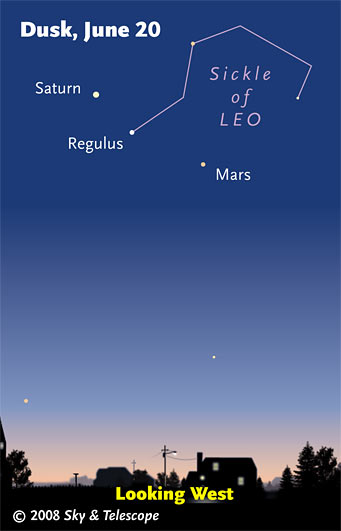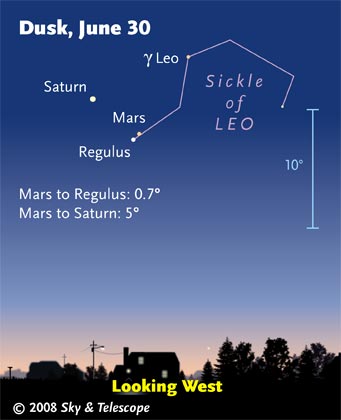Some daily events in the changing sky for June 20 – 28.

All week, Mars draws closer to Regulus and Saturn in the western twilight.
Sky & Telescope diagram
Friday, June 20
In the Northern Hemisphere, it's the longest day and shortest night of the year. The night of the summer solstice was traditionally called Midsummer's Night, a misnomer by the modern definition of the seasons. Traditionally, on this night spirit creatures were thought to be especially apparent (hence Shakespeare's A Midsummer Night's Dream), and the event was celebrated with all-night bonfires.
Saturday, June 21
Sunday, June 22
A complete schedule of Jupiter's interesting satellite events for the month, good worldwide, is in the June Sky & Telescope, page 58. For more about observing Jupiter's satellites, see the July issue, page 62.
Monday, June 23
Tuesday, June 24
In Keystone of Hercules is one of the most familiar deep-sky objects for binocular observers: the globular star cluster M13. But do you know where to pick up the equally bright globular M92 nearby? For both, see "Binocular Highlight" in the July Sky & Telescope, page 54. Get M92 once and it'll be there for you forevermore.
Wednesday, June 25
Thursday, June 26
Friday, June 27
Saturday, June 28

By the end of June, Mars will partner up with similarly bright Regulus under the watch of slightly brighter Saturn off to one side. The blue 10° scale is about the size of your fist held at arm's length.
Sky & Telescope diagram
Want to become a better amateur astronomer? Learn your way around the constellations. They're the key to locating everything fainter and deeper to hunt with binoculars or a telescope. For an easy-to-use constellation guide covering the whole evening sky, use the big monthly foldout map in each issue of Sky & Telescope, the essential magazine of astronomy. Or download our free Getting Started in Astronomy booklet (which only has bimonthly maps).
Once you get a telescope, to put it to good use you'll need a detailed, large-scale sky atlas (set of maps; the standards are Sky Atlas 2000.0 or the smaller Pocket Sky Atlas) and good deep-sky guidebooks (such as Sky Atlas 2000.0 Companion by Strong and Sinnott, the even more detailed Night Sky Observer's Guide by Kepple and Sanner, or the classic Burnham's Celestial Handbook). Read how to use them effectively.
More beginners' tips: "How to Start Right in Astronomy".
This Week's Planet Roundup
Mercury and Venus are still deep in the glare of the Sun.
Mars and Saturn (magnitudes +1.6 and +0.8) are close together in Leo, getting low the west at dusk. Regulus (magnitude +1.4) is between them; midway between on June 23rd. Look early before they sink too low and set.
Mars will pass ¾° from Regulus on June 30th and July 1st.
Jupiter (magnitude –2.7, in eastern Sagittarius) rises in twilight, left of the Sagittarius Teapot. It shines highest in the south around 2 a.m. daylight saving time. Jupiter will reach opposition on July 9th.
Uranus and Neptune (magnitudes 6 and 8, respectively, in Aquarius and Capricornus) are high up in the southeast before the first light of dawn. Use our article and finder charts.
Pluto (magnitude 14.0, in northwestern Sagittarius) is highest in the south around midnight or 1 a.m. But wait till about June 27th, when moonlight will be gone from the sky at that hour.
All descriptions that relate to your horizon or zenith — including the words up, down, right, and left — are written for the world's mid-northern latitudes. Descriptions that also depend on longitude (mainly Moon positions) are for North America. Eastern Daylight Time (EDT) equals Universal Time (UT, UTC, or GMT) minus 4 hours.
---------------------
To be sure to get the current Sky at a Glance, bookmark this URL:
http://SkyandTelescope.com/observing/ataglance?1=1
If pictures fail to load, refresh the page. If they still fail to load, change the 1 at the end of this URL to any other character and try again.
 0
0
Comments
You must be logged in to post a comment.